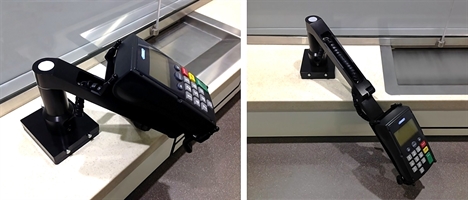17.05.17
Inclusive design of ticket sales counters
Source: RTM Apr/May 17
Boaz Yariv, senior architect, and Dr Elizabeth de Mello, senior ergonomics specialist at Network Rail, present the main features of the new inclusive ticket counter in London Bridge station.
In the last issue of RTM, we described the background considerations behind the design of the new Network Rail ticket office in London Bridge station. We now present the main features of the design.
Dual height continuous counter
The inclusive ticket counter prototype is able to comfortably suit both standing customers and those seated in a wheelchair or mobility scooter, or of lower stature. As well as the full height sales counter, the design incorporates a lower area which can be used for bags by either seated or standing customers, along with a patented flexible transaction tray which can be used by seated or lower stature customers if they wish.
In the past, the requirement to design (separately) for seated or lower stature customers has often resulted in very time-consuming mechanical devices or dedicated low counters. These can be seen to be stigmatising for such users, and uncomfortable for standing users, particularly since the lower counter is often referred to as the ‘DDA’ or ‘disabled’ counter. This design avoids these non-inclusive drawbacks.
Chip & PIN
Another inclusive design initiative is to include the Chip & PIN machine on a suitably positioned extendable arm, so it can be used by both standing and seated customers equally easily.
A glazed screen separates the customer from the ticket office. This design feature applies to most Network Rail stations due to issues concerning station security as well as staff comfort. It is true that in large stations with an expansive number of sales points, there could be good arguments for excluding the glass separation, and this can be accommodated by a design using the same ergonomic principles in such locations.
A security shutter is incorporated externally, so as to provide security to the Chip & PIN machine, and the rest of the ticket office. This is necessary for stations which are open in hours when the ticket office may be closed.
Whilst numerous customers will be affected by the design of the ticket counter, equally important are the ticket office staff who must sell tickets and deal with customer queries throughout their often busy shift. Their workstation has been created to incorporate good ergonomics design principles, whilst at the same time acknowledging that there are inevitable compromises. The design has some key underlying issues which may not always apply in other situations, and these are detailed below.
It is assumed that ticket sales staff will usually work from a standing position. This assumption arose from observations of ticket office staff, and discussions with them. Although there are a range of views on sitting vs standing workstations, recent work has indicated that standing work may be the healthiest option and is generally most favoured by the ticket sales staff. A high-level, fully adjustable chair is provided to allow a change of posture and for periods of rest. The design of the chair is not mandated by the design but it would be expected to meet, for example, the Health and Safety Executive (HSE) Seating at Work Guidance (1997). The base design can be modified for seated staff by providing a suitably raised floor in the ticket office, but this is considered unnecessary in most cases. Ticketing staff who are wheelchair users should be provided with an adjustable height wheelchair which will allow them to work comfortably at the same worktop height.

Display screen equipment users
Ticket sales staff are defined as display screen equipment (DSE) users under the Display Screen Equipment Regulations (1992). The HSE guidance document on these regulations (2003) sets out minimum workstations requirements, and refers to BS EN ISO 9241:5.
This workstation has been designed with these in mind, so as to provide sufficient space for all items the user must use whilst locating items at suitable height and reach distances, and providing adequate leg and knee space under the workstation for those who do need, or wish, to work seated. Although, as explained, this workstation is primarily designed for standing use, there is a chair provided and all seated users would need an adjustable footrest to sit safely and comfortably.
Reach distances have been optimised for both customer and sales staff. When two people face one another across a counter, there will inevitably be some compromise on the worktop depth to ensure that they can both reach anything passed between them. Compromise has been reached in this design after careful consideration and consultation with a range of stakeholders, including wheelchair users. Importantly, it was noted during this process that BS 8300 does not assist designers to provide a comfortable reach distance for both parties in these situations.
The equipment is laid out on the workstation so that the most frequently used item, the cash drawer, is straight in front of the user. When shut, this also forms a convenient writing surface – as users reported that there is a regular need to complete handwritten forms, for example for rail cards or refunds.
Have you got a story to tell? Would you like to become an RTM columnist? If so, click here.